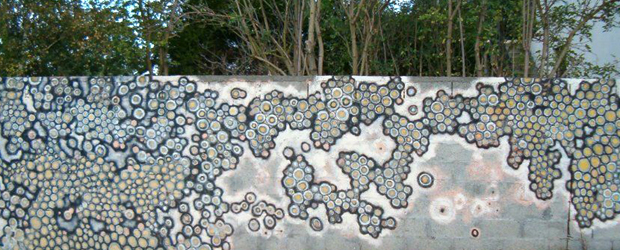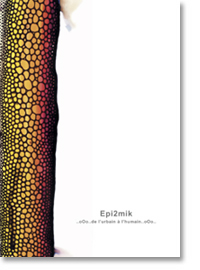In The Transmission of Affect Teresa Breannan describes affective force as a sort of contagious force. One can catch the blues from another, and equally, be infected with shared joy. Thierry O., best known as Epi2mik, a street artist from Caen, Normandie, opened his ephemeral show 22 March 2014 at Cabinet d'Amateur in the 11eme arrondissement, a series of drawings and watercolor paintings that explore the structure of malady in a range of visual forms, ranging from the leering, to the joyful.
 |
| Epi2mik Flyer. Cabinet d'Amateur. Paris, France. 22 March 2014. Photo Credit: Caitlin Bruce |
Epi2mik's show offer's a series of four by six inch panels, at eye level, that run from one end of the small gallery to the next. The opposing wall is punctuated by a few much larger pieces, potentially offering"contaminate the city, its walls, its urban furniture, and its trees."
 |
| Epi2mik. Cabinet d'Amateur. Paris, France. 22 March 2014. Photo Credit: Caitlin Bruce |
an enlarged microscopic view of the structure of the cells across. He notes: "[I use the name] Epi2mik [pronounced 'epidemic'] because I make circles in the street that multiply, like a malady, and I return, again and again to the same location, so that it grows and grows. Here at Cabinet d'Amateur I have done a series of drawings with paint." Asking him to elaborate on the political context for his work he added: "I find that we live in an era of malady. And for those that work in the street, it is a little like a kind of therapy...and for me [epidemic] symbolizes all of what our generation must live within. It is an immediate reaction to the extreme right, and other problems.""Has anything changed, since you began with this epidemic?" "No. For me? No. I continue to work in the street and to also do smaller paintings...its a different kind of work [paintings] but it is something I like to do very much."
Indeed he has noted at greater length what the generalized condition of malady may signify:
« Pour moi, cela symbolise tout ce que notre génération vit de négatif : sida, chômage, corruption, montée de l’extrêmedroite, dérives du capitalisme, etc... La ville est mon tableau. J’essaye de valoriser des endroits abîmés, usés ou désaffectés pour réaliser ces compositions qui sont comme des warnings citoyens. »
For me, this [the circles] symbolize all of the negativity that our generation lives with: HIV, unemployment, corruption, the rise of the extreme right, the drifts of capitalism, etc..The city is my tableau. I try to valorize spaces that are damaged, spent, or unused to create compositions that are warnings for citizens.
 |
| Epi2mik. Cabinet d'Amateur. Paris, France. 22 March 2014. Photo Credit: Caitlin Bruce |
Although each piece is composed of circles, connecting at their edges to form various shapes, their composition, color, and density varies intensely, offering a wide array of emotional states and structures of forms. Although the pieces in the gallery were composed inside, Epi2mik remarked that his larger outdoor projects could take up to ten years to create. "I return one day, and paint a few circles, I leave, and then return another [day] adding yet more..." He further contextualized that he had worked in the street for fifteen years before working in galleries. Patrick, the owner of Cabinet d'Amateur, had contacted him earlier in 2013 to participate in an exposition on street art. "I find it interesting to do drawings, to do things other than what I would do in the street...to work also in color, and in small format."
 |
| Epi2mik. Cabinet d'Amateur. Paris, France. 22 March 2014. Photo Credit: Caitlin Bruce |
I could not encounter the exhibit without thinking of Gilles Deluze's work in Difference and Repetition where repetition is not the eternal return haunted by the tyranny of the same, but instead is always with a difference yielding new and unpredictable outcomes. Such an ethic, to reproduce the same signature (or image) while allowing it to alter and be altered by its surrounding is one that can be read more generally in street art cultures.
 |
| Epi2mik. Cabinet d'Amateur. Paris, France. 22 March 2014. Photo Credit: Caitlin Bruce |
Mon travail est urbain mais n’a pas grand chose a voir avec le graffiti, j’utilise la ville comme espace « rhizomatique » et « micropolitique » mes principales influences sont Gilles Deleuze et Felix Guattaridans « Milles Plateaux« , ou Paul Ardenne dans « Un art contextuel« , ou encore plus proche la contamination de Joel Hubaut.
 |
| Epi2mik. Cabinet d'Amateur. Paris, France. 22 March 2014. Photo Credit: Caitlin Bruce |
My work is urban but it is not exactly like graffiti. I use the city as a "rhizomatic" and "micropolitical" space, and my principle influences are Gilles Deleuze and Felix Guattari in "A Thousand Plateaus", or Paul Ardenne in "A Contextual Art," or yet even more recently the contamination of Joel Hubaut.
Moreover, the simplicity and strength of Epi2mik's compositions, circles that are joined organically, almost (seemingly) accidentally to form a larger organism, is infections. Leaving the exhibit I was able to read patterns in worn patches of sidwalk, and eroded swatchs of retaining walls.
 |
| Visual Contagion. Rue de Reuilly 12eme. Paris, France. 22 March 2014. Photo Credit: Caitlin Bruce |
This exhibit reminds us of one of the qualities of street art that is so powerful. It is not only that street art often offers a disruption or reaestheticization of degraded or ignored urban space. It is that street art, and public art more broadly, provides a reorientation or intensification of vision, allowing us to experience our surroundings anew.
Merci beaucoup à Thierry pour l'entretien, et à Patrick pour l'access à votre superbe galerie. L'expo est fantatique.



No comments:
Post a Comment